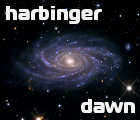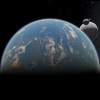|
Abundance of rocky planets on the outskirts of galaxies
|
|
| SlyReaper | Date: Saturday, 01.09.2012, 14:44 | Message # 1 |
 Observer
Group: Users
 United Kingdom
United Kingdom
Messages: 18
Status: Offline
| By my understanding of astrophysics, the outskirts of galaxies are thought to be very metal-deficient. By metal, I mean any element heavier than helium. This should inhibit the formation of rocky planets in these regions. But when I use Space Engine to look at these regions, there doesn't seem to be any shortage of them.
As a suggestion, I think it would be more accurate to have a parameter somewhere in the procedural generation algorithms that causes the number of rocky planets and moons around a star to drop off as you approach the edge of a galaxy. I don't know how easy it would be to code that, but if it's easy, then it would certainly add to the accuracy of the simulation. I've been very impressed at the level of detail and accuracy so far - all seeming to be based on some very sound astrophysics, so the abundance of rocky bodies on the outskirts of galaxies seemed a little jarring.
|
| |
| |
| HarbingerDawn | Date: Saturday, 01.09.2012, 14:53 | Message # 2 |
 Cosmic Curator
Group: Administrators
 United States
United States
Messages: 8717
Status: Offline
| Quote (SlyReaper) As a suggestion, I think it would be more accurate to have a parameter somewhere in the procedural generation algorithms that causes the number of rocky planets and moons around a star to drop off as you approach the edge of a galaxy.
It should be all planets really, since recent evidence shows that gas giants also are dependent on metals to form.
All forum users, please read this!
My SE mods and addons
Phenom II X6 1090T 3.2 GHz, 16 GB DDR3 RAM, GTX 970 3584 MB VRAM
|
| |
| |
| DoctorOfSpace | Date: Saturday, 01.09.2012, 15:01 | Message # 3 |
 Galaxy Architect
Group: Global Moderators
 Pirate
Pirate
Messages: 3600
Status: Offline
| Quote (HarbingerDawn) It should be all planets really, since recent evidence shows that gas giants also are dependent on metals to form.
I thought Gas giants are pre-stars and their cores are metallic hydrogen. If the outer galaxy were primarily helium and hydrogen then gas giants should still form out of the clouds of gas.
There would still be the occasional rocky world even way out, massive stars that have died billions of years ago would still have some of their materials reach that far. I do agree that the numbers should drop off but they should never hit 0.
I was thinking something similar to this a little while ago. There is a supposed galactic habitability zone and I've found many life worlds within the center of galaxies. The amount of radiation in those regions just seems far too high to support life. And on the topic of planets, in the central region of the galaxy there should be a larger number of carbon worlds and larger rocky worlds.
Intel Core i7-5820K 4.2GHz 6-Core Processor
G.Skill Ripjaws V Series 32GB (4 x 8GB) DDR4-2400 Memory
EVGA GTX 980 Ti SC 6GB
|
| |
| |
| SlyReaper | Date: Saturday, 01.09.2012, 15:14 | Message # 4 |
 Observer
Group: Users
 United Kingdom
United Kingdom
Messages: 18
Status: Offline
| Quote (HarbingerDawn) It should be all planets really, since recent evidence shows that gas giants also are dependent on metals to form.
I'd be interested in seeing those studies. Like DOS, I thought gas giants were able to form without metals.
|
| |
| |
| HarbingerDawn | Date: Saturday, 01.09.2012, 15:18 | Message # 5 |
 Cosmic Curator
Group: Administrators
 United States
United States
Messages: 8717
Status: Offline
| Quote (DoctorOfSpace) I thought Gas giants are pre-stars and their cores are metallic hydrogen.
Gas giants do have metallic hydrogen in their interiors, but that is not what is at their cores (at least not for any that we have good data on). Gas giants like Jupiter and Saturn have cores of rock and metal. It is possible that these large worlds were the seeds around which the gas later accreted, or perhaps not. In any case, recent exoplanet survey data shows that even gas giants are much more common around stars with higher metalicities. I wish I could find the article, there's more to it than I've tried to explain, but I don't have time right now, I'll try to dig it up later.
All forum users, please read this!
My SE mods and addons
Phenom II X6 1090T 3.2 GHz, 16 GB DDR3 RAM, GTX 970 3584 MB VRAM
|
| |
| |
| DoctorOfSpace | Date: Saturday, 01.09.2012, 15:22 | Message # 6 |
 Galaxy Architect
Group: Global Moderators
 Pirate
Pirate
Messages: 3600
Status: Offline
| Quote (HarbingerDawn) shows that even gas giants are much more common around stars with higher metalicities.
Well that seems kind of obvious really. The higher metal would give a body a greater mass and the gas would be pulled around it. However there still seems to be the possibility that if all you have is helium, hydrogen, and little to no metal you would still get a "pure" gas giant with a metallic hydrogen core from the pressure. Just as you still get stars from when the universe formed and there was only hydrogen and possibly helium.
Intel Core i7-5820K 4.2GHz 6-Core Processor
G.Skill Ripjaws V Series 32GB (4 x 8GB) DDR4-2400 Memory
EVGA GTX 980 Ti SC 6GB
|
| |
| |
| SlyReaper | Date: Saturday, 01.09.2012, 15:24 | Message # 7 |
 Observer
Group: Users
 United Kingdom
United Kingdom
Messages: 18
Status: Offline
| And how do we know Jupiter and Saturn have rocky cores? No probe has ever been down to look that deep. I'm not doubting you, I'm just curious.
|
| |
| |
| SpaceEngineer | Date: Sunday, 02.09.2012, 15:44 | Message # 8 |
 Author of Space Engine
Group: Administrators
 Russian Federation
Russian Federation
Messages: 4800
Status: Offline
| Quote (SlyReaper) And how do we know Jupiter and Saturn have rocky cores? No probe has ever been down to look that deep. I'm not doubting you, I'm just curious.
There are models of interior compositions of every planet. They use measured small variances in planetary gravitational potential to detect density distribution inside the planet, our knowledge of properties of various materials (how density depends on pressure and temperature), and knowledge which elements and materials could exist in space and their amounts (for example a planet cannot be made of gold, because gold is a very rare element in space).
*

|
| |
| |
 ENG
ENG




 United Kingdom
United Kingdom 



 United States
United States 
 Pirate
Pirate  Russian Federation
Russian Federation 